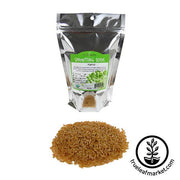Certified Organic Kamut Grain - Bulk Grains
Kamut as a Garden Plant
In North America, Kamut is grown in Montana and Canada. Kamut is closely related to durum wheat and should be grown in the same way. It is much more drought-resistant than most varieties of wheat. Because it has not been crossbred or modified from its original state, it grows best in the same regions as its origins, the Fertile Crescent. Broadcast Khorasan wheat seeds into a garden plant in the spring and cover with about an inch of soil and tamp it down. Water sparingly, about an inch per week.
Popular Uses
Kamut wheat berries are two times as large as other wheat varieties. Kamut can be used in the kitchen as a wheat grain or barley grain replacement. Use Kamut in soups, grain salads, pilafs, stir-fries, bread making, breakfast porridges, or mill it into flour. Kamut can be grown as wheatgrass and then juiced in the same way and packs a nutrient-rich punch.
Store Kamut® in a dry, cool, dark area with temperatures ranging between 62 and 68 degrees Fahrenheit. The life of many grains can be extended for up to 10-12 years, and as long as 30 years longer in some cases, when meticulous storage is maintained. This seed is an excellent addition to your emergency food stores.
- Breakfast foods
- Stir-fries
- Pilafs
- Soups and stews
- Salads
- Wheatgrass
- Baking
History
Khorasan wheat gets its name from the region in present-day Afghanistan where it is believed to have originated and was cultivated. Khorasan wheat has a number of nicknames including "prophet's wheat", as some believe that Noah brought Khorasan on the ark with him, and "King Tut's Wheat" because a WWII airman found it near a pyramid in Egypt.
Khorasan found its way to Montana after WWII that same airman sent a handful to his father's farm. The wheat had been nearly forgotten when Bob Quinn, an Organic farmer in Montana, began to study it and uncovered its exceptional qualities.
Health Benefits
Kamut® is higher in protein than most modern wheat and some people who are sensitive to modern wheat find that they have less trouble with Kamut®. Indeed its popularity is due in large part to this aspect (but check with your doctor first if you do have a wheat allergy). Research conducted on behalf of Kamut International has shown that 70% of people who have sensitivities to modern wheat, can tolerate Kamut® brand Khorasan wheat. It is an excellent alternative to modern wheat, as it is always Organically grown and non-GMO.
Additionally, Kamut® wheat contains a higher percentage of lipids and amino acids and is also higher in many minerals, especially selenium, zinc, and magnesium compared to modern wheat.
=======




















 Sprouting
Sprouting